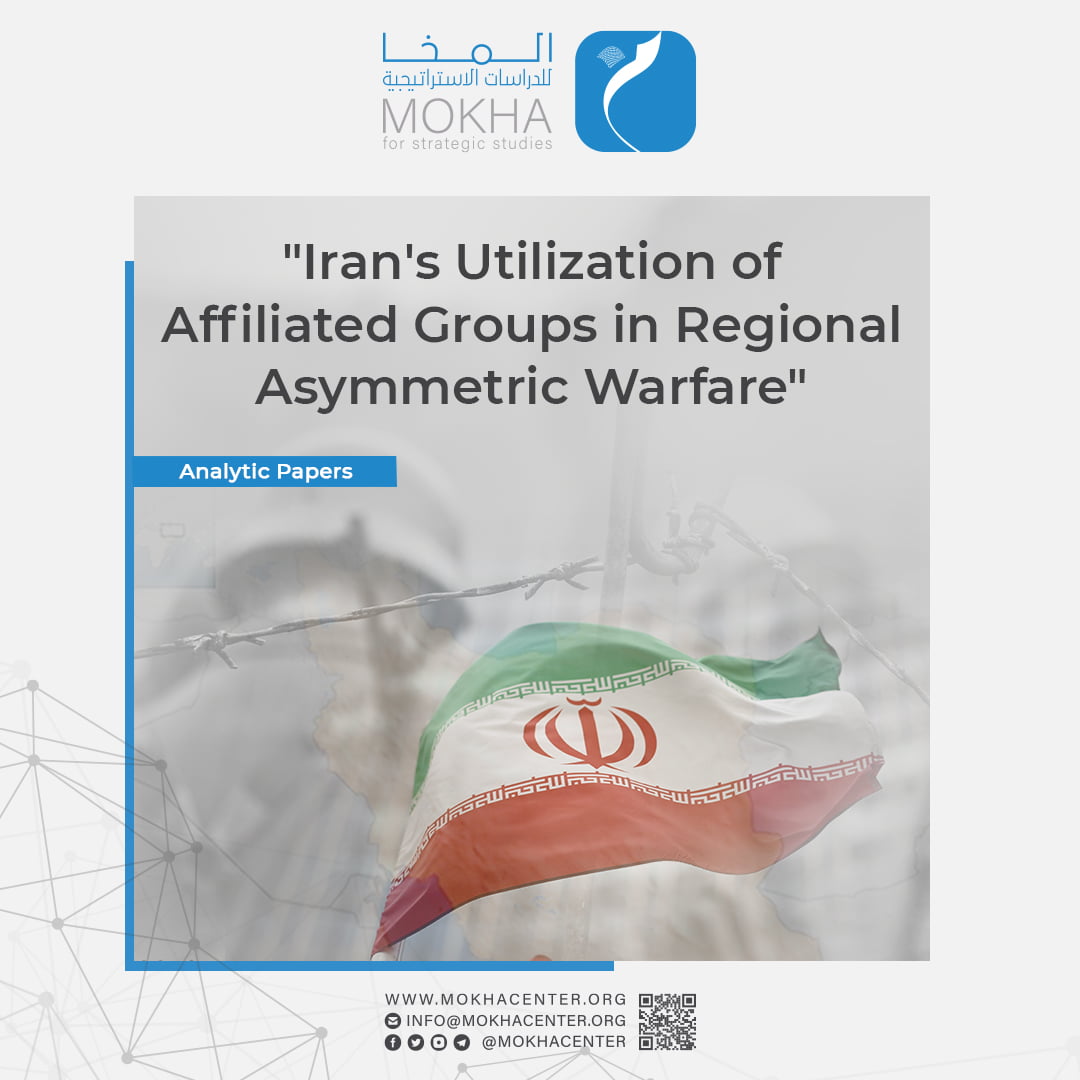“Iran’s Utilization of Affiliated Groups in Regional Asymmetric Warfare”

| Getting your Trinity Audio player ready... |
In the past half-century, global developments have reshaped the landscape of warfare, giving rise to a distinct form of it known as “asymmetric warfare.” Unlike traditional conflicts between regular state armies, asymmetric war involves a significant power imbalance between opposing parties. It is categorized as a type of fourth-generation war, characterized by non-state actors such as militias, organizations or armed groups challenging state powers.
Asymmetric war has emerged due to several factors. Advancements in technology, the expansion of the battlefield through globalization and ideological mobilization have all contributed to its evolution. In this type of warfare, the weaker party exploits these factors to target the vulnerabilities of the stronger opponent, preventing them from achieving their objectives.
Iran has strategically utilized asymmetric war by supporting and controlling militias and armed groups across multiple countries such as Lebanon, Iraq, Syria and Yemen. By doing so, Iran aims to advance its regional dominance objectives. This strategy involves pressuring the removal of foreign forces, particularly American, British and Turkish troops, to create a power vacuum for Iran to fill. Iran has also employed these armed entities to exert pressure on neighboring countries, notably Saudi Arabia, the UAE and Jordan. In recent times, Iran has further involved these groups in regional conflicts, particularly amidst the ongoing genocide carried out by Israel against the Palestinians in the Gaza Strip.
What is asymmetric warfare? What factors have contributed to its rise? And how has Iran employed asymmetric warfare to achieve its military and political goals in the region?
Asymmetric Warfare:
Asymmetric warfare involves a military conflict in which one party consists of militias or armed groups, while the other is a state. There’s a notable disparity in strength between the two parties, in terms of military capabilities and in strategies and tactics. Each side aims to exploit the weaknesses of the other. The weaker party employs strategies to compensate for its lack of superior forces and equipment1, which may not always be purely military in nature.2
The term “asymmetric warfare” traces its origins back to the late 1970s, when American writer Andrew Mark posed several inquiries in an article regarding the United States’ defeat, despite its formidable strength, against modestly powerful guerrilla forces in Vietnam. Around the same period, the American military strategists began pondering similar questions. These discussions culminated in the formulation of the term “asymmetric warfare,” capturing the essence of modern, unconventional and asymmetrical warfare tactics. This form of warfare is categorized as a type of “Fourth-Generation Warfare”3 (4GW).4
Mark’s analysis initially went unnoticed, but with the end of the Cold War, American academic and military communities began to show interest in the concept. Since 2004, American military forces started to address the challenges associated with asymmetric warfare more seriously. This concept became closely associated with guerrilla warfare, insurgency, terrorism, counterinsurgency and counterterrorism.
Characteristics of Asymmetric Warfare:
- Asymmetric warfare involves a conflict between a state or states and an armed group or groups.
- There is a significant difference in military capabilities between the warring parties, with the armed group(s) lacking the military strength of the state(s).
- Unlike conventional wars with defined territorial boundaries, the geographical scope of asymmetric wars remains open and may extend beyond specific regions.
- Asymmetric conflicts can affect the interests and citizens of the warring state(s) globally, rather than being confined to a specific area.
- The weaker party is often driven by extremist ideologies or perceived just causes, such as the case with Palestinian resistance factions, fueling a strong resolve to fight.
- Asymmetric warfare is characterized by decentralized operations, where each group or party autonomously plays a role in the conflict.
- Advanced military tactics and technologies, including drones, smart missiles and guerrilla warfare tactics, are utilized by the weaker party for sabotage and damage.
The variables that led to the emergence of asymmetric wars:
Several political, technological and military factors have contributed to the emergence of modern warfare, including asymmetric warfare. The most significant variables include:
- High Cost of Conventional Wars:
Traditional wars between state armies have become expensive in terms of economic, political and human costs. They often pose existential threats to less powerful states, especially when confronting a superpower. For this reason, many countries are reluctant to engage in conventional wars against other nations. This reluctance is evident in Arab and Islamic countries such as Egypt, Turkey, Jordan and Iran, which refrained from involvement in the ongoing conflict in Palestine due to the significant military presence of Western powers in the region. The possession of nuclear weapons by certain countries further discourages conventional warfare, as it limits conflicts to restricted clashes or prolonged wars of attrition without escalating to nuclear warfare5. In light of these challenges, expansionist nations tend to resort to asymmetric warfare through proxies or local agents, as demonstrated by Iran’s actions in the region.
- State Fragility and Militia Dominance:
Since the end of the Cold War in 1990, several countries have experienced varying degrees of fragility, weakness or outright collapse. This phenomenon has been fueled by the resurgence of ethnic identities, including religious, sectarian, ethnic, geographical and tribal affiliations. Militias or armed groups have emerged based on these identities, seizing control of state authority or usurping its functions. These militias often become involved in internal or external conflicts, exacerbating instability, which has affected some surrounding countries, including Somalia, Iraq, Libya, Lebanon, Syria, Sudan, Yemen and various African nations.
As a consequence, the nature and sources of worldwide conflicts have evolved. According to the United Nations, a significant portion of conflicts today involves non-state actors such as political militias, criminal groups and international terrorist organizations. These conflicts are fueled by unresolved regional tensions, the breakdown of the rule of law and the absence or co-option of state institutions.6
- Advancements in Weapon Technology:
The evolution of military weapons technology, particularly with the advent of unmanned aircraft, has revolutionized warfare. Drones now play a pivotal role in various military and intelligence operations, including reconnaissance, surveillance and targeted attacks. Their effectiveness has led to widespread ownership, with over a hundred countries and groups possessing armed drones. Notably, China serves as a major supplier of armed drones worldwide, expanding access beyond traditional military powers7. Middle powers, like Iran and Turkey, have also acquired this technology and export their systems. Adding to that, commercial drone technology is widely available, enabling groups, including terrorist organizations, to develop attack capabilities at low costs. Similar advancements are seen in unmanned ships, submarines, smart missiles and integrated task capabilities across various military platforms. The accessibility of advanced military weapons has significantly bolstered the role of militias and armed groups in asymmetric warfare, making it a prevalent form of conflict globally.
- Communication Technology and Information Transfer:
Significant advancements in communication and data-transfer technology, including various communication channels and social media platforms, have facilitated rapid and widespread dissemination of information. This has empowered individuals to become sources of data, ideas and sentiments, facilitating the mobilization and propagation of extremist ideologies by militias and armed groups, particularly those rooted in sectarian, religious or geographical identities. These technologies have fueled emotional mobilization and perpetuated a continuous readiness for conflict.
- How Iran Employed Armed Militias to Fight an Asymmetric War on its Behalf:
Iran has employed armed militias affiliated with it in other countries to conduct a combination of proxy and asymmetric warfare, aiming to achieve its regional political and military objectives. This strategy is implemented with strategic awareness and planning by Iranian leaders, recognizing the effectiveness of asymmetric warfare in pursuing their goals.
Iranian policy provides a clear model of how a country can employ armed groups, affiliated with it, in other countries to conduct a combination of proxy war and asymmetric war on its behalf, in order to achieve its regional political and military objectives. This strategy is implemented with strategic awareness and planning by Iranian leaders, recognizing the effectiveness of asymmetric warfare in pursuing their goals.
In a recent interview with a media outlet, former Iraqi Foreign Minister Hoshyar Zebari said, in a closed meeting with high-ranking Iranian leader Qassem Soleimani, “I explained that the Islamic Republic regime is threatened by what they described as global arrogance and global Zionism and … Iran needs to protect its regime and fight its opponents and enemies outside its borders, by forming irregular forces and … Iran may not be able to engage in conventional wars with countries.”8
Iran has a history of supporting groups, like Hezbollah in Lebanon, and exacerbating chaos in Iraq following the U.S. occupation in 2003. It capitalized on the fight against ISIS to militarize Shiite movements loyal to it, transforming them into armed militias such as the Hezbollah Brigades, Al-Nujaba Movement, Asa’ib Ahl al-Haq and others. These militias, funded by the Popular Mobilization Forces in Iraq, have become significant forces within the country, rivaling and even surpassing the Iraqi army in certain aspects of armament.
Iran leveraged the war in Syria to establish and deploy several military militias loyal to its interests, including the Afghan Fatemiyoun and the Pakistani Zainabiyoun. These militias operated under the command of the Quds Force and actively participated in battles alongside the Syrian army in areas such as Aleppo and Deir el-Zor. While estimates vary, experts suggest their numbers range from 25,000 to 40,000 fighters, subject to fluctuation based on operational needs.9
Additionally, Iran provided comprehensive support to the Houthis in Yemen, encompassing military, political, media and financial assistance. This support enabled the Houthis to engage in asymmetric warfare with the Yemeni state from 2004 to 2010, culminating in their seizure of power in 2014. Later on, they engaged in a protracted conflict with regional rivals such as Saudi Arabia and the UAE, including attacks on international shipping and American military assets.
On top of that, Iran utilized its armed militias to launch attacks on American military bases in both Iraq and Syria, aiming to eject them from these countries. Tehran perceives the American military presence as an impediment to its efforts to expand influence in the region, thus engaging in a struggle for dominance with the United States.
- Involvement in the Clash as a Result of the War on Gaza:
In the wake of the Israeli military aggression against Gaza, armed groups in the region, affiliated with Iran, found political justification to launch attacks against Israel or American military presence in Iraq and Syria, under the pretext of supporting Gaza. Iran provided support to these groups by deploying advisors and soldiers from the Iranian Revolutionary Guard to work alongside militias in Iraq and Syria, in addition to supporting Syrian regime forces. What’s more, Iran equipped these militias with drones and smart missiles to influence asymmetric warfare, similar to its support for the Houthi group in Yemen. According to what some reports indicated, Iran worked to supply the Houthis with unmanned submarines. “A platform affiliated with the U.S. Naval Institute revealed that Iran has sent unmanned submarines to the Houthis in Yemen and that it is using them to attack ships in the Red Sea.” According to an article published by the “US Navy News” website, the U.S. Central Command’s announcement that its naval forces had destroyed an unmanned underwater vehicle in Houthi-controlled waters around Yemen is considered a new threat entering the conflict.10
Other Supporting Factors:
The involvement of armed groups and militias aligned with the Iranian axis is influenced by their composition, support from Iran, strategic planning and, to some extent, is affected by the Western stance. Recent history indicates that the West tends to handle organizations and militias backed by Iran differently, showing less sensitivity, precaution and violence compared to other groups in the region. This distinction was evident during the Gaza conflict, when the United States, under the banner of preventing regional war escalation, overlooked numerous strikes targeting its interests and forces in Iraq, Syria and maritime areas, like the Red Sea and Gulf of Aden. The response to these attacks exhibited a flexible containment approach, contrasting with Western dealings with groups affiliated with the broader Sunni movement, both politically and violently.
Furthermore, several factors deterred non-Shiite groups from direct involvement in the regional conflict:
- Many non-Shiite groups lack a militant nature, having exhausted violence in previous conflicts or facing significant scrutiny and criticism at national, regional and international levels.
- Most of these groups refuse to operate beyond the authority of their respective states.
- Many of these groups bear the responsibility of rebuilding their war-torn countries, anticipating that Western positions could hinder their efforts.
Resources
- A future vision: Asymmetrical wars … the fourth generation and beyond, Diaa El-Din Zaher, International Politics Magazine, on: 11/27/2014, available at the following link: https://www.siyassa.org.eg/News/15189.aspx
- As in the current Russian-Ukrainian war.
- A New Era of Conflict and Violence, United Nations, available at:
https://www.un.org/ar/un75/new-era-conflict-and-violence
- Drones: Why do they represent a new phase on the battlefield? (Translated from Arabic) BBC, on: 6/2/2022, available at the following link:
- Zebari to “Asharq Al-Awsat”: We heard frank words in Tehran explaining the role of the militias, Al-Sharq Al-Awsat newspaper, on: 2/19/2024, available at the following link: https://n9.cl/1stfu0
- What are the militias and armed groups loyal to Iran in Iraq and Syria? (Translated from Arabic) BBC, on: 10/28/2023, available at the following link:
https://www.bbc.com/arabic/articles/c99q0wwvwreo
- U.S. Naval Institute: Iran handed over to the Houthis drone submarines that they use to attack ships in the Red Sea, Al-Masdar Online, on: 2/20/2024, available at the following link: https://almasdaronline.com/articles/290564




